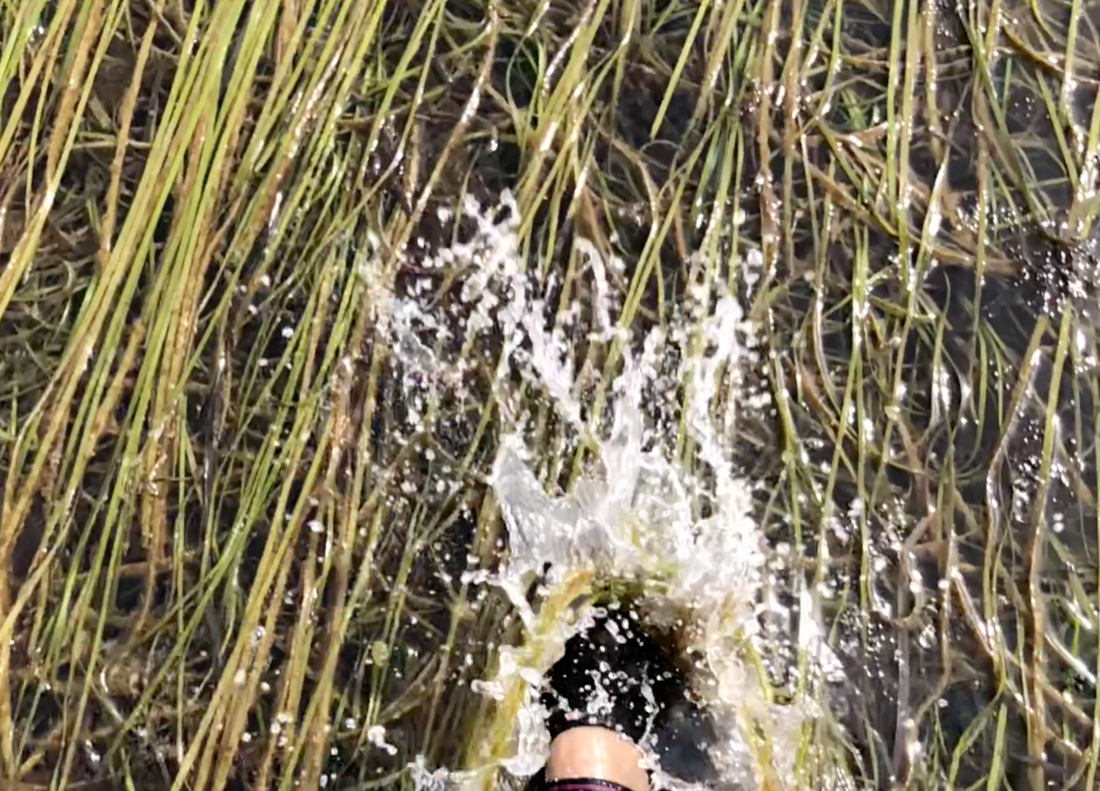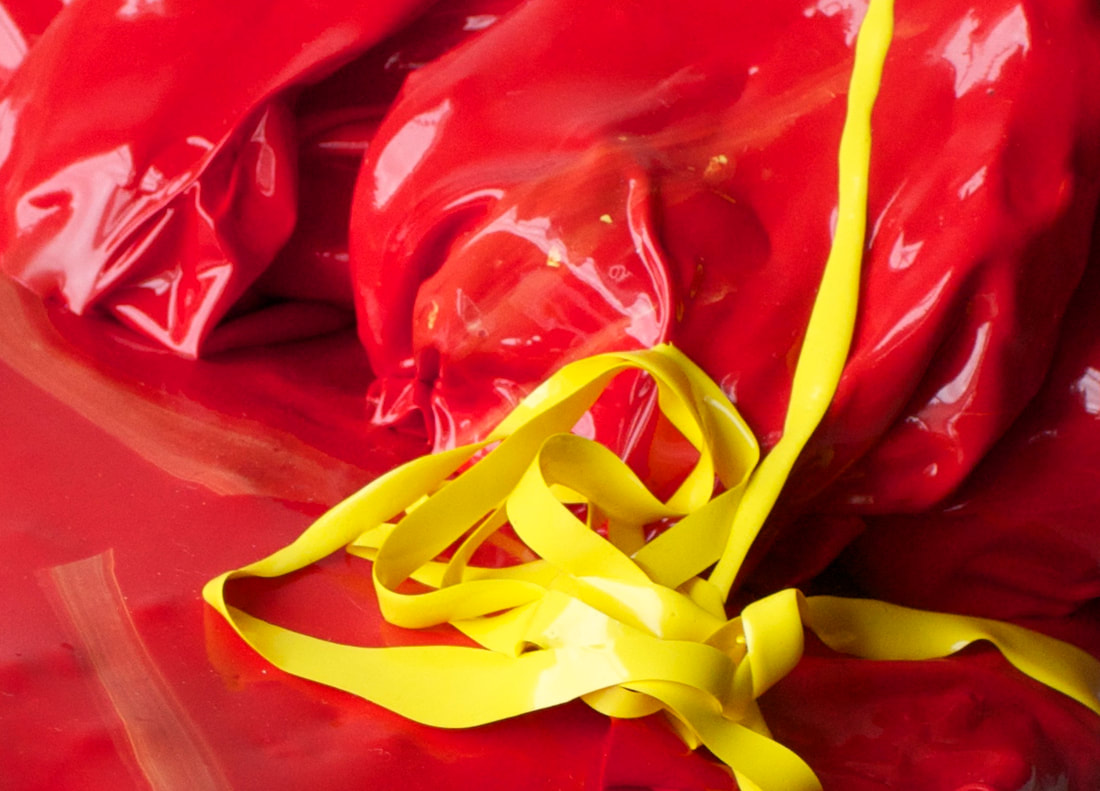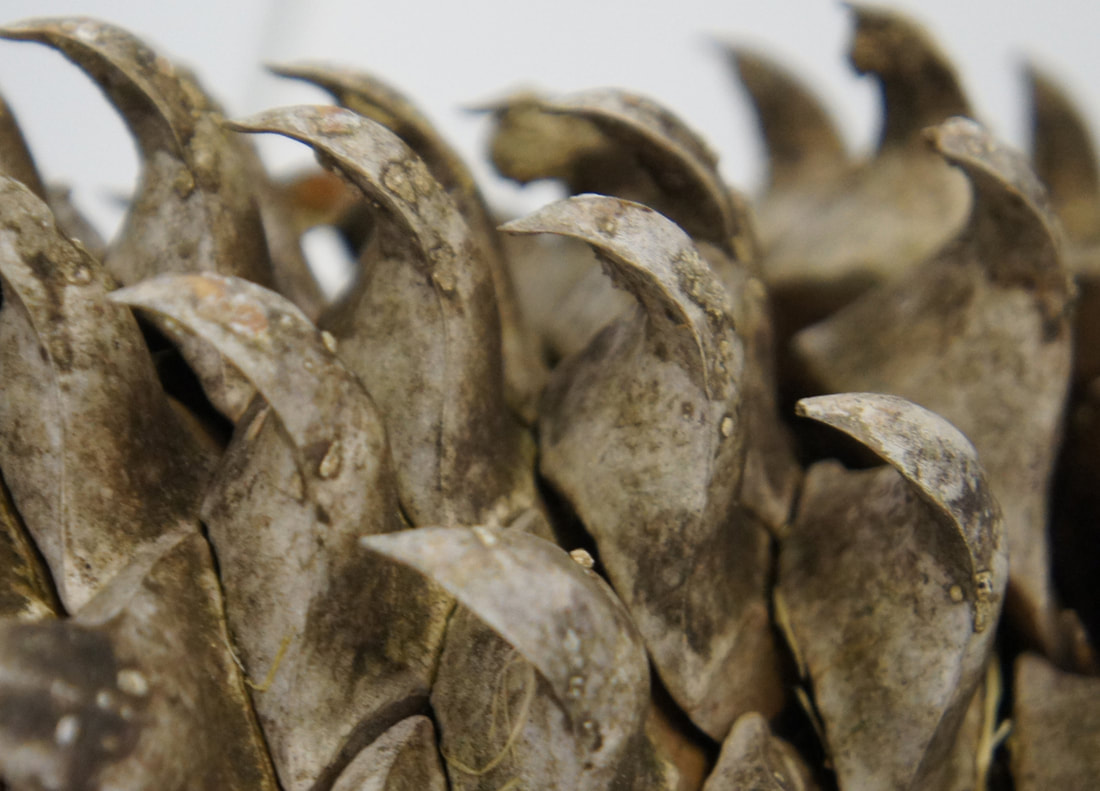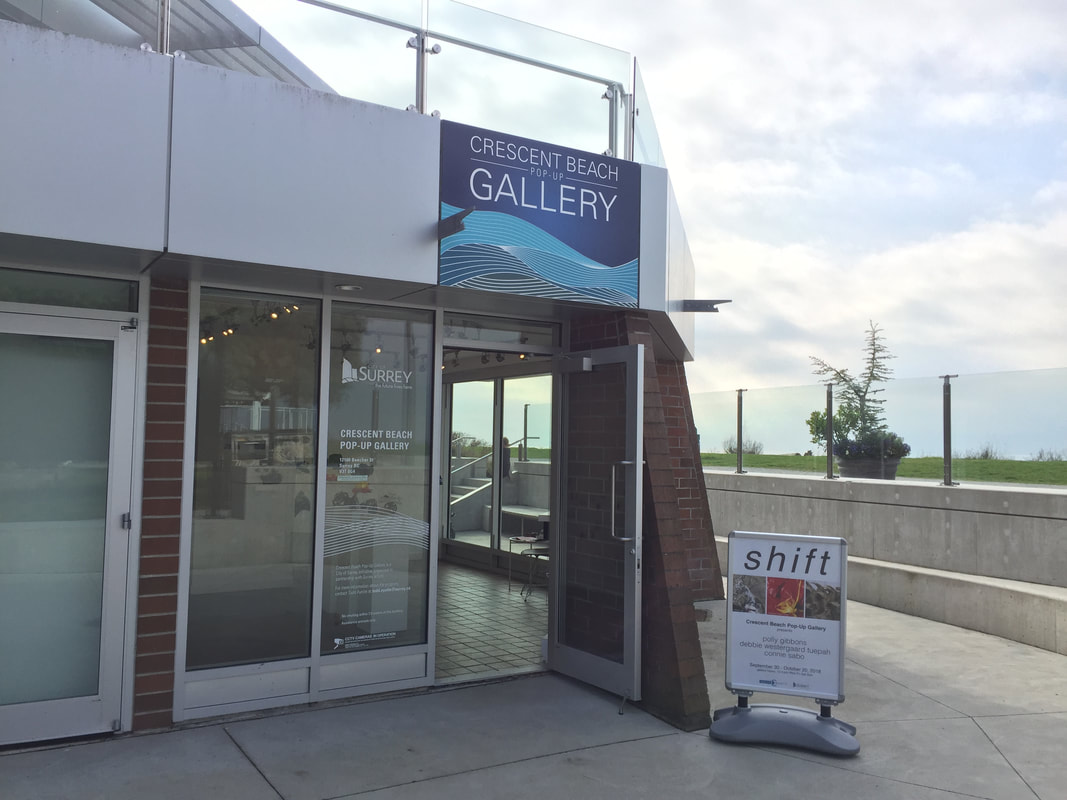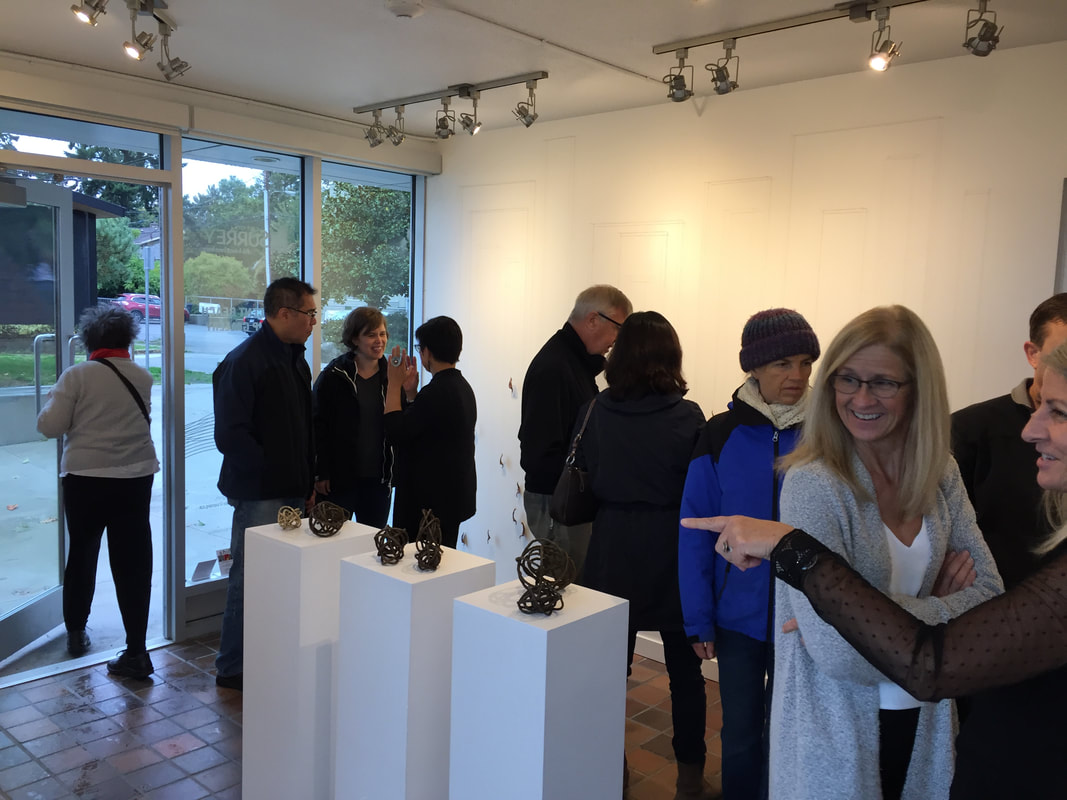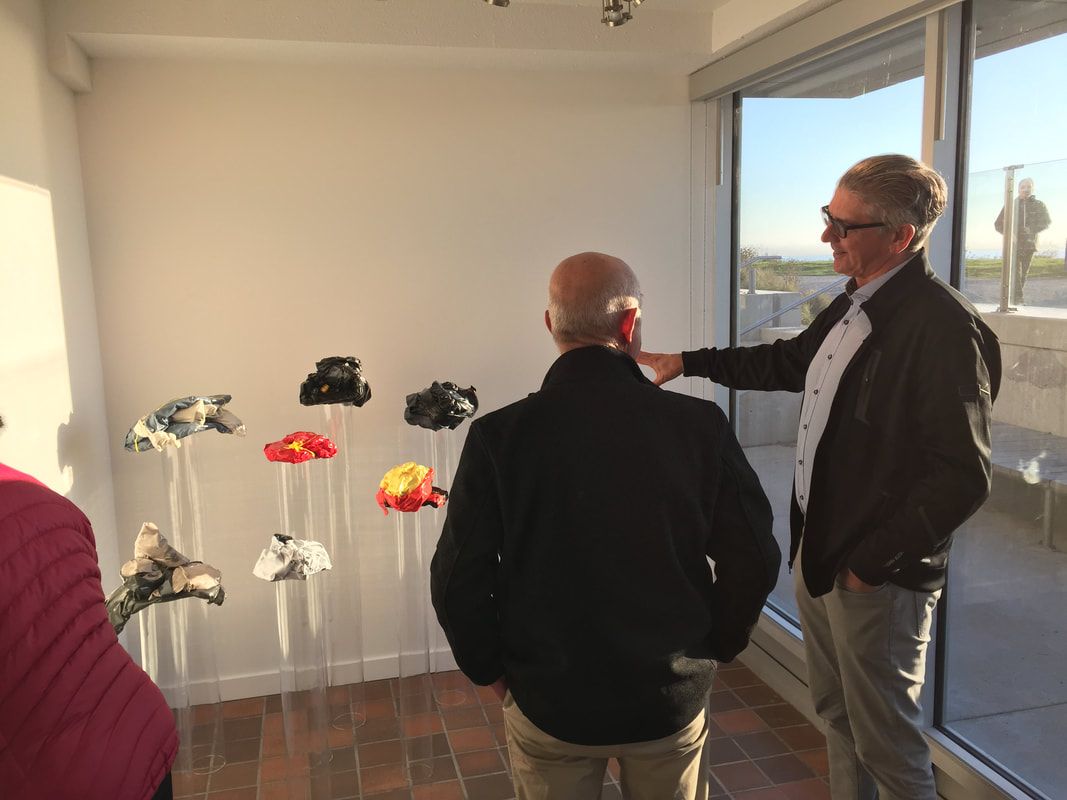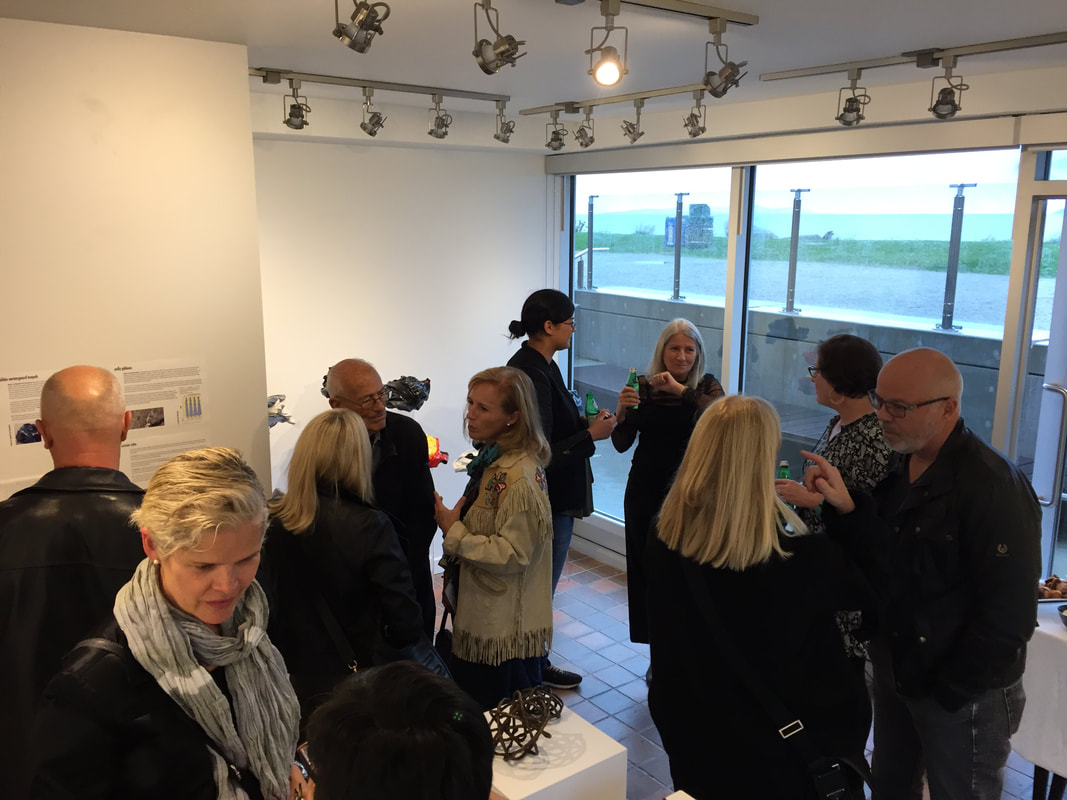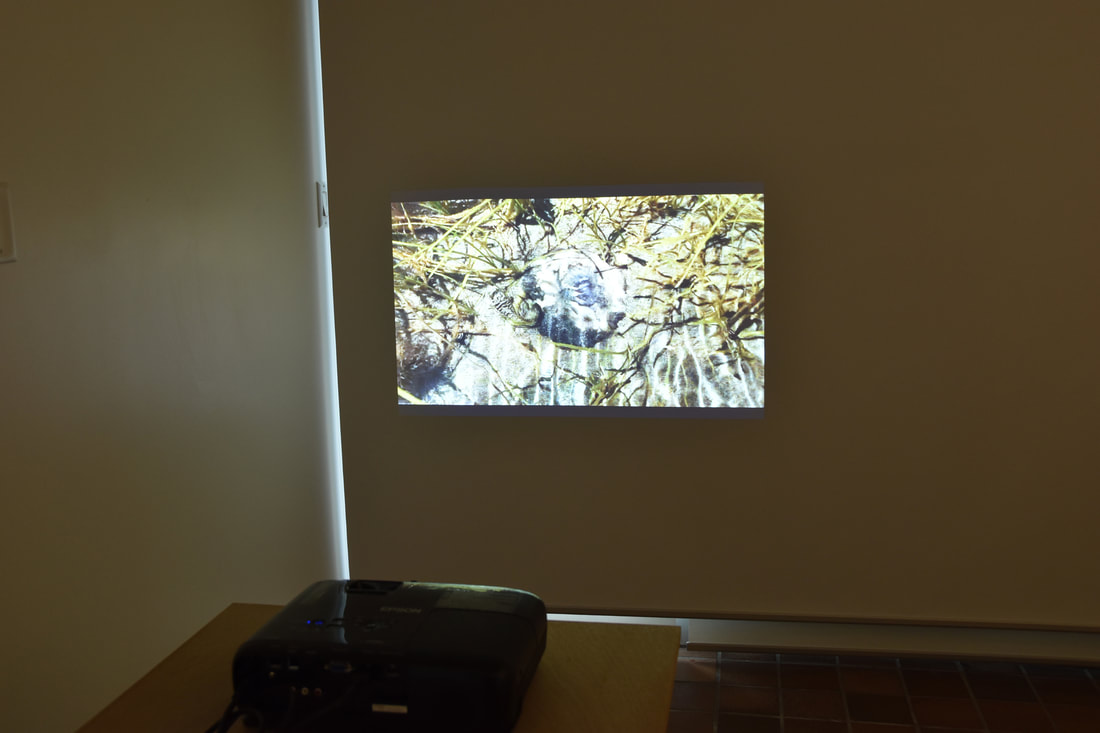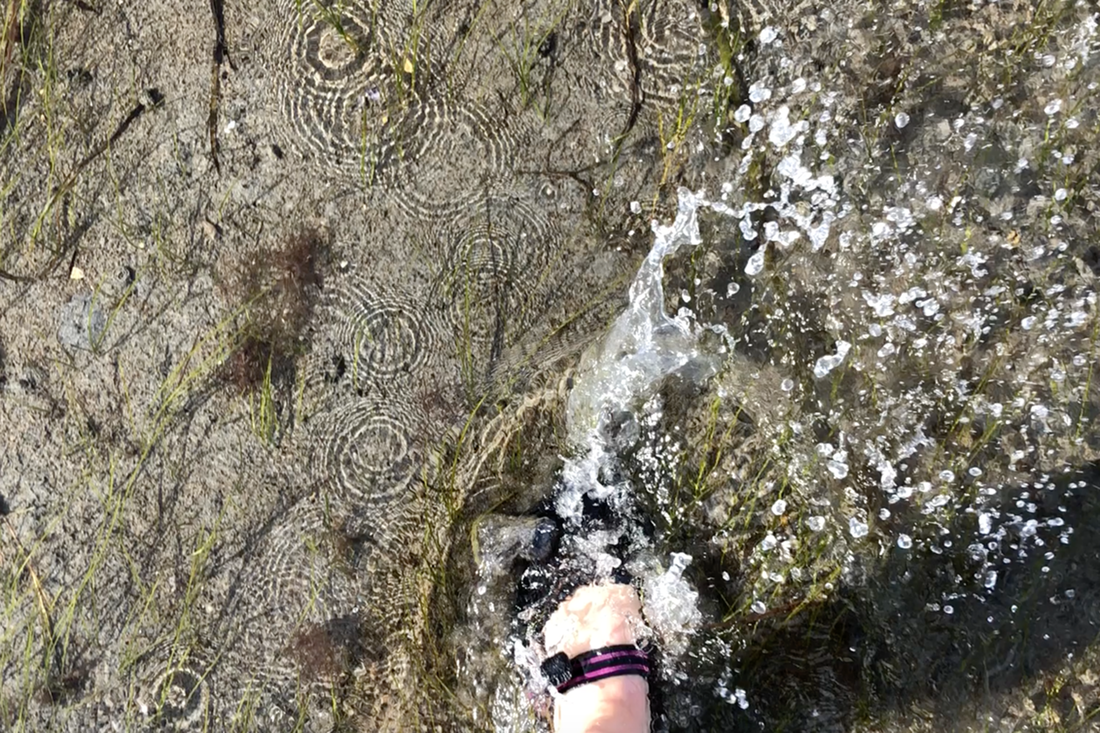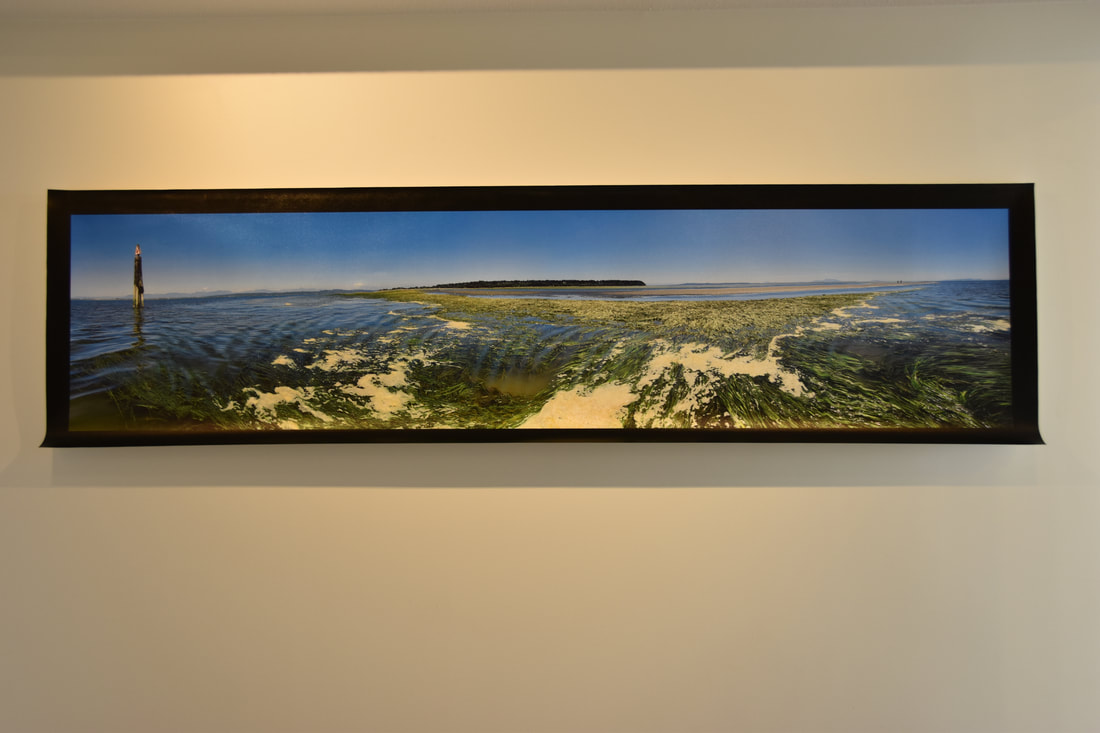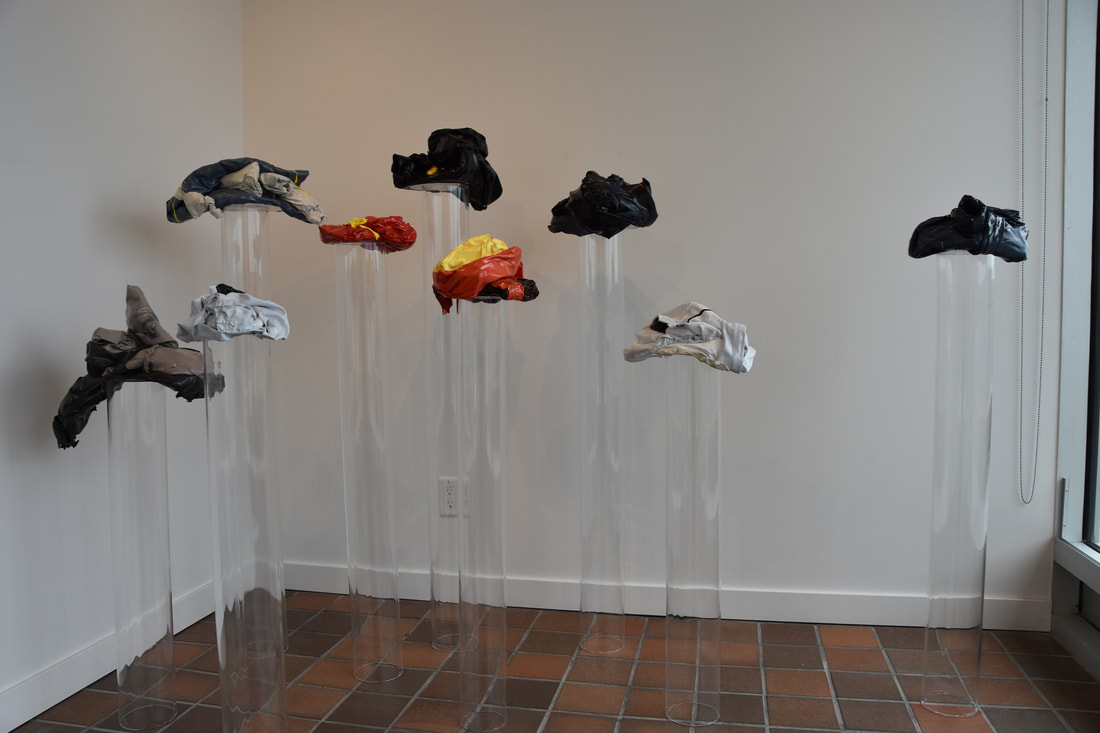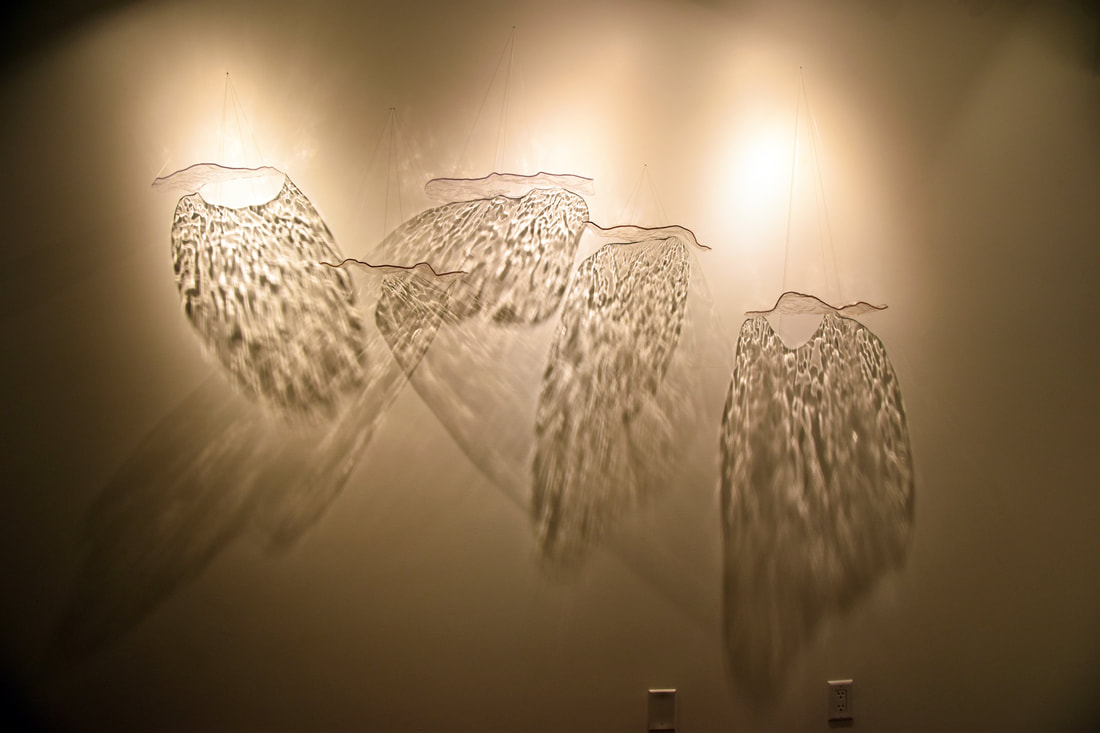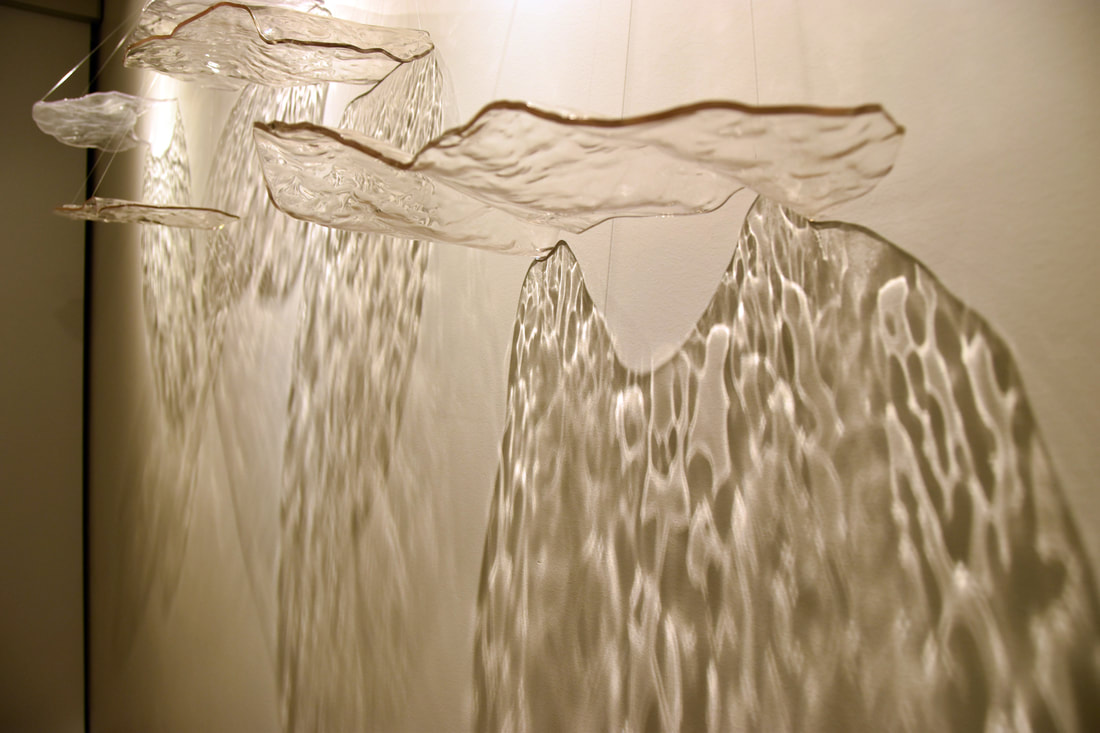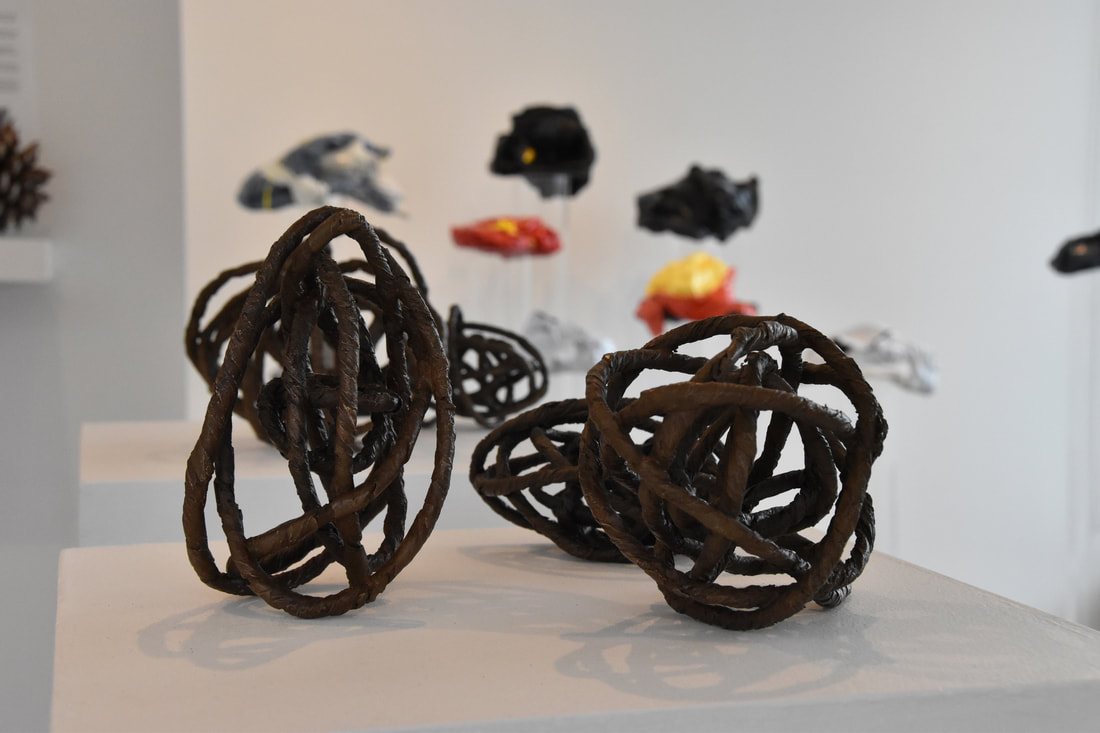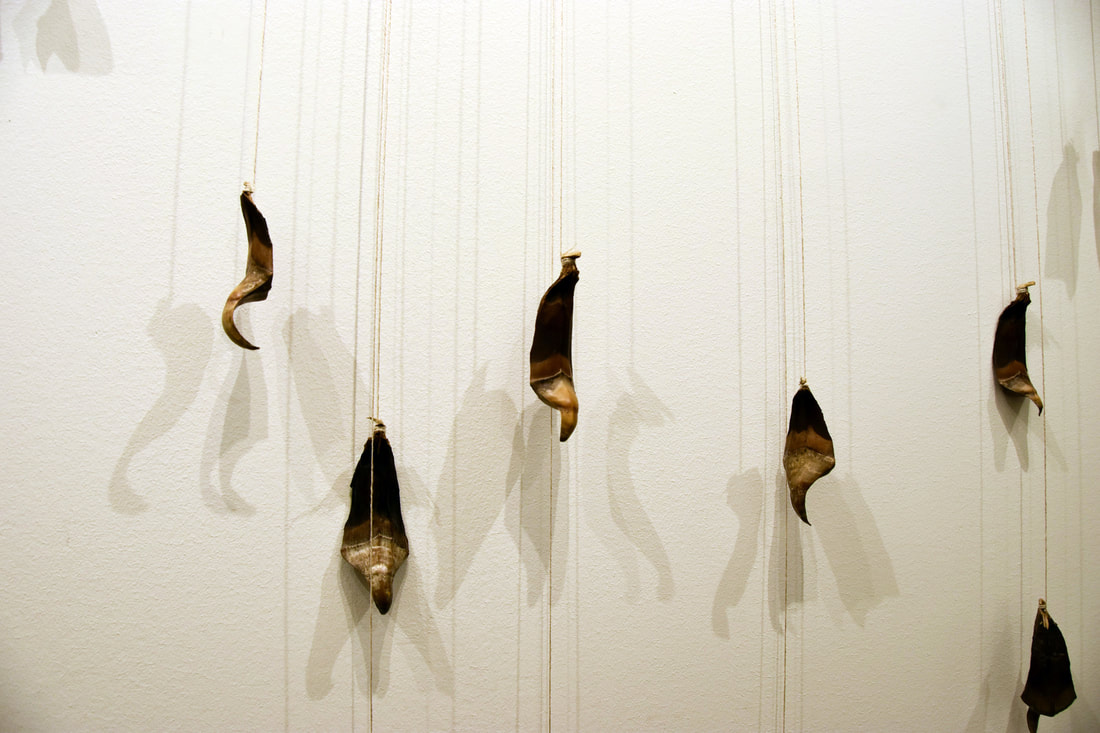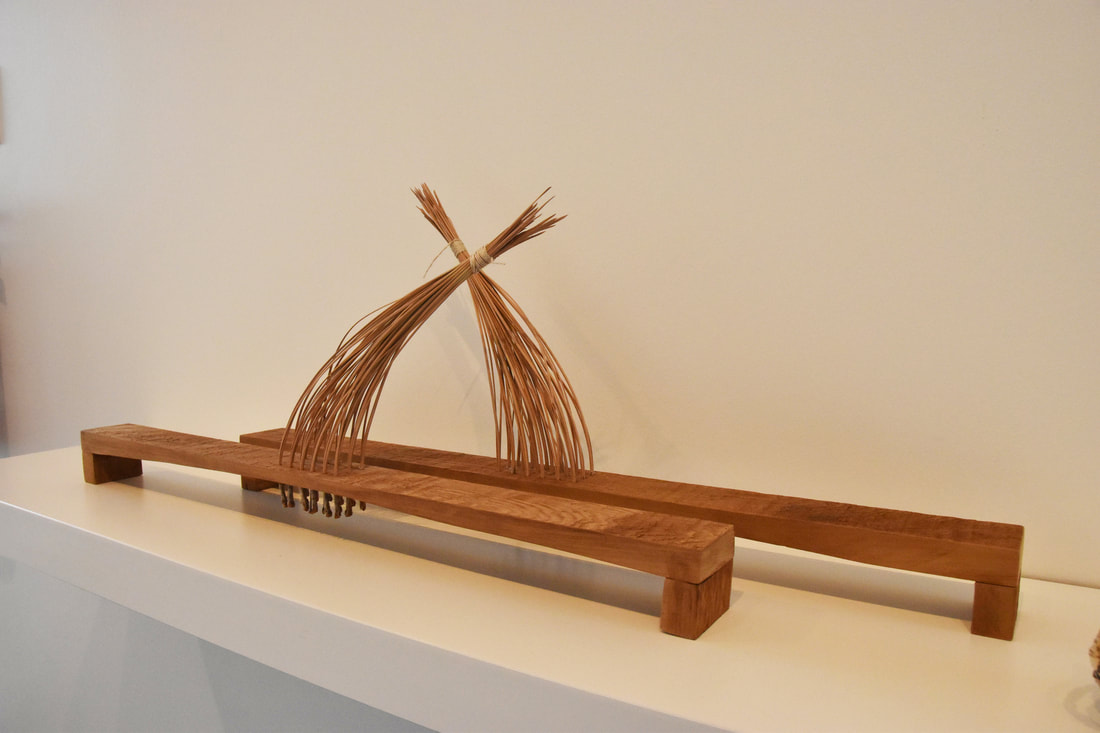SHIFT: Polly Gibbons | Debbie Westergaard Tuepah | Connie Sabo
Crescent Beach PopUp Gallery
September 30 - October 21, 2018
The cyclical patterns of the organic and inorganic are explored through diverse media by artists Polly Gibbons, Connie Sabo, and Debbie Westergaard Tuepah, in Shift.
Through the embodied and physically challenging process of learning about sea and shore in her quest to learn to surf, Polly Gibbons investigates neuroplasticity, the process of shaping and molding her brain through her experiences and surroundings. Using video and photography Gibbons shares her research in the form of Lowest Low Tide Beach Walk at Crescent Beach, where she travelled through the intertidal zone to reach the low tide line. With Memes, Connie Sabo redefines information by twisting old newsprint into cords that are woven into elemental nuggets. Cast in bronze, and resembling a pine cone, her memes encapsulate fragments of culture or communication, encasing and protecting the information within. Fine Balance is a reversal of this process with Sabo separating the scales of Coulter Pine cones, the armoured protectors of the trees’ DNA, to reveal a tenuous but undeniable connection to nature and the secret communication of the organic. In her work a Conversation, Sabo’s upright stacks of needles lean into each other, seemingly eager to connect or converse. Debbie Westergaard Tuepah uses paint, and found or readymade materials, such as acrylic ice remnants from the 2010 Winter Olympics, to consider the conceptual and embodied experience of information in relation to contemporary issues and events. Her work, Nodes: Lac Megantic Train Derailment, and Meltdown interrogate the risk of a train derailment, and the impact of global warming on our coastal residents, the fragile ecosystem of Crescent Beach, and our local floodplain, which includes 20% of Surrey’s land.
September 30 - October 21, 2018
The cyclical patterns of the organic and inorganic are explored through diverse media by artists Polly Gibbons, Connie Sabo, and Debbie Westergaard Tuepah, in Shift.
Through the embodied and physically challenging process of learning about sea and shore in her quest to learn to surf, Polly Gibbons investigates neuroplasticity, the process of shaping and molding her brain through her experiences and surroundings. Using video and photography Gibbons shares her research in the form of Lowest Low Tide Beach Walk at Crescent Beach, where she travelled through the intertidal zone to reach the low tide line. With Memes, Connie Sabo redefines information by twisting old newsprint into cords that are woven into elemental nuggets. Cast in bronze, and resembling a pine cone, her memes encapsulate fragments of culture or communication, encasing and protecting the information within. Fine Balance is a reversal of this process with Sabo separating the scales of Coulter Pine cones, the armoured protectors of the trees’ DNA, to reveal a tenuous but undeniable connection to nature and the secret communication of the organic. In her work a Conversation, Sabo’s upright stacks of needles lean into each other, seemingly eager to connect or converse. Debbie Westergaard Tuepah uses paint, and found or readymade materials, such as acrylic ice remnants from the 2010 Winter Olympics, to consider the conceptual and embodied experience of information in relation to contemporary issues and events. Her work, Nodes: Lac Megantic Train Derailment, and Meltdown interrogate the risk of a train derailment, and the impact of global warming on our coastal residents, the fragile ecosystem of Crescent Beach, and our local floodplain, which includes 20% of Surrey’s land.
Polly Gibbons is an interdisciplinary artist interested in the points of convergence between the sciences and the arts. Her prior life in brain research informs her ongoing art research in neuroplasticity. She is dedicated to a lifelong practice in “making her own brain.” She has undergraduate degrees in biopsychology and fine arts, and in 2016 she completed her MFA at Emily Carr University of Art + Design. She is a member of AgentC Projects and the SOFIA/Collective. Born in Seattle, Washington, she has made her home in South Surrey since 2002.
Lowest Low Tide Beach Walk — I have been going on low tide beach walks for the past couple of years. They are part of a long-term art research project exploring neuroplasticity. Neuroplasticity is the ability of our brain to be shaped and molded by our experiences and surroundings. When we learn something new we are changing our brain. I have set a goal for myself to learn to surf. I see this as a fully embodied and physically challenging process of sculpting my own brain. The first phase of this process has been learning about the sea from the shore. I like watching how the waves interact with the shoreline. Watching the waves led me to the low tide beach walks. I consult tide tables to guide my walks so that I can safely journey to the waters edge without fear of getting stranded by an incoming tide.
July 13, 2018 at 12:15 pm was a special date and time at Crescent Beach as it marked the lowest low tide for the year. On that date I travelled through the intertidal zone to reach the low tide line. I collected video and photographs and a few sand dollars along the way there and back. The panorama photo was taken from the low tide line looking back across the intertidal zone. If you look very carefully you can see Beecher Place way off in the distance from where I was standing along the low tide line during the lowest low tide of the year.
Lowest Low Tide Beach Walk — I have been going on low tide beach walks for the past couple of years. They are part of a long-term art research project exploring neuroplasticity. Neuroplasticity is the ability of our brain to be shaped and molded by our experiences and surroundings. When we learn something new we are changing our brain. I have set a goal for myself to learn to surf. I see this as a fully embodied and physically challenging process of sculpting my own brain. The first phase of this process has been learning about the sea from the shore. I like watching how the waves interact with the shoreline. Watching the waves led me to the low tide beach walks. I consult tide tables to guide my walks so that I can safely journey to the waters edge without fear of getting stranded by an incoming tide.
July 13, 2018 at 12:15 pm was a special date and time at Crescent Beach as it marked the lowest low tide for the year. On that date I travelled through the intertidal zone to reach the low tide line. I collected video and photographs and a few sand dollars along the way there and back. The panorama photo was taken from the low tide line looking back across the intertidal zone. If you look very carefully you can see Beecher Place way off in the distance from where I was standing along the low tide line during the lowest low tide of the year.
Debbie Westergaard Tuepah is a Surrey-based visual artist who uses primarily yarn, paint, found, and readymade objects to consider the conceptual and embodied experience of information in relation to contemporary issues and events. She has exhibited her sculpture, installation, painting and community engagement works both nationally and in the US. www.debbietuepah.com
Nodes: Lac Megantic Train Derailment interrogates a single but widely shared news image of the 2013 Lac-Mégantic train derailment in Lac-Mégantic, Quebec. Broken down mathematically the image is reduced to colours with assigned weights. These weights and colours are converted to volumes of paint, which are ultimately sculpted into ‘nodes’. Like pixels, or nodes as referenced in science — small masses of differentiated anatomical tissue, or the place in a standing wave that has little or no amplitude — this works delves into the detail of an image, encouraging a similar pause and contemplation, a crossover between viewer, context, and the reality of human experience. In the context of the Crescent Beach area, significant increases in the number of trains travelling through this community, the subsequent erosion of the land surrounding the tracks, and the types of materials being transported, pose an ever increasing risk to the area’s residents and visitors, and the natural surroundings. Even with very recent federal funding to increase safety of the line in the short term, local government and constituents are working for a full relocation plan.
Using plastic “ice” remnants from the 2010 Winter Olympics as metaphor for the world’s disappearing ice, Meltdown responds to the macro issue of global warming. It is predicted that sea level will rise by one metre by 2100, a reality that has coastal communities working proactively to reduce risk. Locally, low-lying coastal floodplains encompass Semiahmoo First Nation, and 20% of Surrey’s land area, including Crescent Beach, Boundary Bay, Mud Bay, the Nicomekl, Serpentine and Campbell Rivers, Cloverdale, and Newton. And yet, many are apt to push it’s overwhelming impact out of their minds, particularly as it relates to a long term view. Meltdown is a call for change at a micro-level, with attention given to sourcing actionable information that as individuals we can relate to, and act upon.
Nodes: Lac Megantic Train Derailment interrogates a single but widely shared news image of the 2013 Lac-Mégantic train derailment in Lac-Mégantic, Quebec. Broken down mathematically the image is reduced to colours with assigned weights. These weights and colours are converted to volumes of paint, which are ultimately sculpted into ‘nodes’. Like pixels, or nodes as referenced in science — small masses of differentiated anatomical tissue, or the place in a standing wave that has little or no amplitude — this works delves into the detail of an image, encouraging a similar pause and contemplation, a crossover between viewer, context, and the reality of human experience. In the context of the Crescent Beach area, significant increases in the number of trains travelling through this community, the subsequent erosion of the land surrounding the tracks, and the types of materials being transported, pose an ever increasing risk to the area’s residents and visitors, and the natural surroundings. Even with very recent federal funding to increase safety of the line in the short term, local government and constituents are working for a full relocation plan.
Using plastic “ice” remnants from the 2010 Winter Olympics as metaphor for the world’s disappearing ice, Meltdown responds to the macro issue of global warming. It is predicted that sea level will rise by one metre by 2100, a reality that has coastal communities working proactively to reduce risk. Locally, low-lying coastal floodplains encompass Semiahmoo First Nation, and 20% of Surrey’s land area, including Crescent Beach, Boundary Bay, Mud Bay, the Nicomekl, Serpentine and Campbell Rivers, Cloverdale, and Newton. And yet, many are apt to push it’s overwhelming impact out of their minds, particularly as it relates to a long term view. Meltdown is a call for change at a micro-level, with attention given to sourcing actionable information that as individuals we can relate to, and act upon.
Connie Sabo is a Vancouver based artist. She grew up in East Vancouver, graduated UBC in 1982 and received the Governor General’s Medal of Excellence from the Emily Carr Institute of Art + Design in 2003. Her sculpture and mixed media installations are often site-specific, exploring issues of cycles and sustainability as well as personal intimate relationships with the environment and the urban landscape. She challenges the physicality and cultural history of materials and techniques. By introducing alternative materials to traditional methods and vice versa, her work explores the past, present and future. www.conniesabo.com
Connie’s work evolves through a meditative and explorative process. She literally unwinds information. Twisting old newsprint into long cords she reveals hidden messages and personal connections. These cords are often woven into nets; catching ideas, they are hung to invade, explore, or connect the space they inhabit. Her Memes stem from this work. The remnants of cord are woven into elemental nuggets that encapsulate fragments of culture or communication. Cast in bronze, the Meme’s information is encased and protected, obscuring the process and the secret code within. Connie’s mimetic clusters now more closely resemble the Coulter Pine cones that she carefully dissects.
Reversing and repeating her process Connie methodically separates a cone’s scales, the armoured protectors of the trees’ DNA, and now, empty of their pine tree QR code she suspends them from linen threads. A Fine Balance reveals a tenuous but undeniable connection to nature and suggests the secret communication in the organic world.
A Conversation is voiced again from that which is discarded. Her upright stacks of needles lean into each other, seemingly eager to connect or converse. Our own relation to these needles is usually experienced underfoot as we pass beneath the forest canopy. Shed needles carpet the ground, protecting and regenerating the soil and as we disturb their slippery rest, they speak their quiet and distinct stories in silvery whispers.
Connie’s work evolves through a meditative and explorative process. She literally unwinds information. Twisting old newsprint into long cords she reveals hidden messages and personal connections. These cords are often woven into nets; catching ideas, they are hung to invade, explore, or connect the space they inhabit. Her Memes stem from this work. The remnants of cord are woven into elemental nuggets that encapsulate fragments of culture or communication. Cast in bronze, the Meme’s information is encased and protected, obscuring the process and the secret code within. Connie’s mimetic clusters now more closely resemble the Coulter Pine cones that she carefully dissects.
Reversing and repeating her process Connie methodically separates a cone’s scales, the armoured protectors of the trees’ DNA, and now, empty of their pine tree QR code she suspends them from linen threads. A Fine Balance reveals a tenuous but undeniable connection to nature and suggests the secret communication in the organic world.
A Conversation is voiced again from that which is discarded. Her upright stacks of needles lean into each other, seemingly eager to connect or converse. Our own relation to these needles is usually experienced underfoot as we pass beneath the forest canopy. Shed needles carpet the ground, protecting and regenerating the soil and as we disturb their slippery rest, they speak their quiet and distinct stories in silvery whispers.

